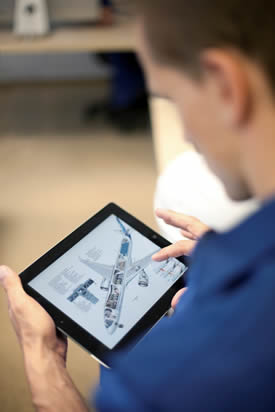|
With the ever-growing requirements for maintaining the global aviation fleet, appropriate and timely maintenance training remains one of the most pressing issues uniting the minds of the
aviation industry around the globe.
On the one hand the so-called 'millennials', or 'Generation Y', currently making up around a third of the global workforce, might make the industry’s adaption to new technologies easier as
they have more experience using computers than wrenches. On the other hand however, as they usually expect to stay in a job for less than three years, retaining the new workforce
might appear to be the real challenge.
As the most populous generation since the baby-boomers, the millennials are forecast to make up almost half the global workforce by 2020. However, millennial employees being a lot
different from previous generations may create serious issues for organizations failing to acknowledge this fact. For instance, a recent study by Bentley University found that 59% of
business decision makers give recent college graduates a C grade or lower for preparedness for their first jobs. The same study also showed that 68% of corporate recruiters say it is
difficult for their organisations to manage millennials.
In addition, according to the U.S. Bureau of Labor Statistics, while the average worker today is expected to stay at a job for just over 4.4 years, in the case of younger employees the
number is about half of that. This means retaining the valuable workforce must become a number one priority, especially for an industry as reliant on experience-based safety results as
aviation.
|
“While marketers, retailers and technologists have gone to great lengths to analyse and adapt for the requirements of millennial consumers, educators and industry alike have struggled to
prepare this generation effectively for the world of work," says Kestutis
Volungevicius, Head of Engineering and Training at Lithuania-based FL
Technics.
"In addition, as latest employment statistics back up the perception that millennials are frequent job changers, there is additional pressure to ensure higher engagement in the industry
already at the training stage. In order to do that, however, we must first understand what makes the generation so different from those before.”
|
 |
|
Kestutis
Volungevicius |
According to Volungevicius, perhaps the most striking difference between millennials and any other generation is that they are the first generation of digital natives. As a result, the
interconnection between the aviation sector and emerging technologies is one of the few reasons why millennials are actually pursuing a career in MRO. For instance, a recent report
issued by the U.S. Government Accountability Office confirmed that the aerospace industry, including the maintenance sector, is experiencing a relatively insignificant aviation workforce
shortage, the hiring level being predicted to remain steady over the next 10 years. However, recruitment aside, harnessing the true power of millennials isn’t that easy.
 |
Young professionals today are no longer attracted by the excitement of an aviation career alone. They look for structure, technology proficiency, and advancement opportunities. So while
it’s true that an aviation maintenance company can expect millennials to easily embrace new digital tools, it’s also true that they do not want to be micro-managed as they would also like
the freedom to be creative and innovative. The key is therefore to shift the emphasis away from the simple consumption of training content to making instructional content intuitive and
accessible, allowing extension of instructional experiences through participation.
Furthermore, having a team that prioritizes
communication will most likely lead to stronger, more
coherent working relationships, which can help create a more collaborative and productive work
environment, while encouraging individual efforts and innovation. |
“A smooth transition from current practices to a new culture, preferred by millennials, will help transform the work and training experience for young employees, which will ultimately
translate into a higher employee retention rate and superior work output," says Volungevicius. "One way to achieve this is to embrace workforce mobility concepts, adopt new
management practices that focus on individual employee roles and stimulate employee involvement in decision making, while identifying the new employees’ needs and wants.
"By simply understanding millennials the industry might be able not only to capture their attention, but also to turn them into a highly skilled, powerful aviation workforce that can empower
our businesses for long-term success,” he concludes.
|